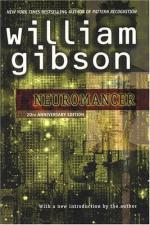|
This section contains 5,542 words (approx. 19 pages at 300 words per page) |

|
SOURCE: Davidson, Cynthia. “Riviera's Golem, Haraway's Cyborg: Reading Neuromancer as Baudrillard's Simulation of Crisis.” Science-Fiction Studies 23, no. 2 (July 1996): 188-98.
In the following essay, Davidson discusses Neuromancer in terms of postmodern theories of simulation and the visual image, particularly comparing the novel's central themes to the works of Jean Baudrillard.
Baudrillard's “Simulacra and Simulacrum” is a study of the degeneration of the integrity of the image so far as it is representative of the real. Early in the essay, Baudrillard discusses the “imperialism” of “present-day simulators”:
Something has disappeared. The sovereign difference between them that was the abstraction's charm. For it is the difference which forms the poetry of the map and the charm of the territory, the magic of the concept and the dream of the real. This representational imaginary, which both culminates in and is engulfed by the cartographer's mad project of an ideal coextensivity between the...
|
This section contains 5,542 words (approx. 19 pages at 300 words per page) |

|


